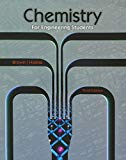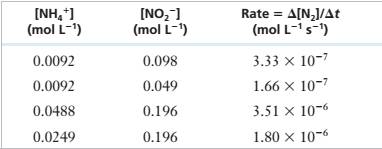
The following experimental data were obtained for the reaction of \'I14* and NOf in acidic solution.
NH/(aq) + NO2-(aq) — N;(g) + 2 H,O(f)
| INH/I (mol L1) | [NO21 (mol L-1, | Rate = A[NJ/At (mol L-1 s’) |
| 0.0092 | 0.098 | 3.33 X IO"7 |
| 0.0092 | 0.049 | 1.66 X 10‘7 |
| 0.0488 | 0.196 | 3.51 X 10"6 |
| 0.0249 | 0.196 | 1.80 X 10-6 |
Determine the rate law for this reaction and calculate the rate constant.
Interpretation: Given the experimental data obtained for a reaction, determine the rate law for the reaction and the value of rate constant
Concept Introduction: Orders of reaction are constantly determined by doing experiments. Consequently without experimental information, we can't conclude anything about the order of a reaction just by having a look at the equation for the reaction. By doing experiments involving a reaction between A and B, the rate of the reaction is identified to be related to the concentrations of A and B as follows:
This is the Rate Equation.
Where,
Rate is in the units of mol dm-3s-1
k is the rate constant
A, B- concentrations in mol dm-3
a - Order of reaction with respect to A
b- Order of reaction with respect to B
Answer to Problem 11.33PAE
Solution: The rate law of the reaction is
Explanation of Solution
Given information: Reaction of
Experimental Data

Step 1: For the reaction:
The rate law can be determined using the rate equation as follows:
Where,
a= Order of the reaction with respect to
b= Order of the reaction with respect to
Step 2: From the first and second rows of the given experimental data,
Step 3: Divide (1) by (2), we get
Step 4: From the third and fourth rows of the given experimental data,
Step 5: Divide (3) by (4), we get
Step 6: Rate Equation = >
To determine k, pick equation (1)
It does not make a difference what the number of reactants there are. The concentration of every reactant will be present in the rate equation, raised to some power. These powers resemble the individual orders with respect to each reactant. The sum of these powers results in the overall order of the reaction. The rate constant will be a constant value for a given reaction only if the concentration of the reactants is changed without changing any other factors.
Want to see more full solutions like this?
Chapter 11 Solutions
Bundle: Chemistry for Engineering Students, 3rd, Loose-Leaf + OWLv2 with QuickPrep 24-Months Printed Access Card
- Regular ?ights of supersonic aircraft in the stratosphere ale of concern because such aircraft produce nitric oxide, NO, as a byproduct in the exhaust of their engines. Nitric oxide reacts with ozone, and it has been suggested that this could contribute to depletion of the ozone layer. The reaction NO+O3NO2+O2 is first order with respect to both NO and O3 with a rate constant of 2.20107 L/mol/s. What is the instantaneous rate of disappearance of NO when [NO]=3.3106 M and [O3]=5.9107M?arrow_forwardThe acid-catalyzed iodination of acetone CH3COCH3(aq) + I2(aq) CH3COCH2I(aq) + HI(aq) is a common laboratory experiment used in general chemistry courses to teach the method of initial rates. The reaction is followed spectrophotometrically by the disappearance of the color of iodine in the solution. The following data (J. P. Birk and D. L Walters, Journal of Chemical Education, Vol. 69, p. 585, 1992) were collected at 23 C for this reaction. Determine the rate law for this reaction.arrow_forwardThe rate of photodecomposition of the herbicide piclo- ram in aqueous systems was determined by exposure to sunlight for a number of days. One such experiment produced the following results. (Data from R.T. Hedlun and C.R. Youngson, “The Rates of Photodecomposition of Picloram in Aqueous Systems," Fate of Organic Pesticides in tbe Aquatic Environment, Advances in Chemistry Series, #111, American Chemical Society (1972), 159—172.) Exposure Time, t (days) [Pidoram] (mol L_1) 0 4.14 X 10-6 7 3.70 X 10-6 14 3.31 X 10-6 21 2.94 X 10~6 28 2.61 X 10~6 35 2.30 X 10-6 42 2.05 X 10-6 49 1.82 X 10"6 56 1.65 X 10-6 Determine the order of reaction, the rate constant, and the half-life for the photodecomposition of picloram.arrow_forward
- The color change accompanying the reaction of phenolphthalein with strong base is illustrated below. The change in concentration of the dye can be followed by spectrophotometry (Section 4.9), and some data collected by that approach are given below. The initial concentrations were [phenolphthalein] = 0.0050 mol/L and [OH] = 0.61 mol/L. (Data are taken from review materials for kinetics at chemed.chem.purdue.edu.) (For more details on this reaction see L Nicholson, Journal of Chemical Education, Vol. 66, p. 725, 1989.) (a) Plot the data above as [phenolphthalein] versus time, and determine the average rate from t = 0 to t = 15 seconds and from t = 100 seconds to t = 125 seconds. Does the rate change? If so, why? (b) Use a graphical method to determine the order of the reaction with respect to phenolphthalein. Write the rate law, and determine the rate constant. (c) What is the half-life for the reaction?arrow_forwardA drug decomposes in the blood by a first-order process. A pill containing 0.500 g of the active ingredient reaches its maximum concentration of 2.5 mg/ 100 mL of blood. If the half-life of the active ingredient is 75 min, what is its concentration in the blood 2.0 h after the maximum concentration has been reached?arrow_forwardFor a certain reaction, Ea is 135 kJ and H=45 kJ. In the presence of a catalyst, the activation energy is 39% of that for the uncatalyzed reaction. Draw a diagram similar to Figure 11.14 but instead of showing two activated complexes (two humps) show only one activated complex (i.e., only one hump) for the reaction. What is the activation energy of the uncatalyzed reverse reaction?arrow_forward
- What is the difference between average rate, initial rate, and instantaneous rate?arrow_forwardWhen formic acid is heated, it decomposes to hydrogen and carbon dioxide in a first-order decay. HCOOH(g) CO2(g) + H2(g) At 550 C, the half-life of formic acid is 24.5 minutes. (a) What is the rate constant, and what are its units? (b) How many seconds are needed for formic acid, initially 0.15 M, to decrease to 0.015 M?arrow_forwardLabel the elementary processes for the reaction between H2 and O2 see section 20.7 as initiation, propagation, branching, or termination reactions.arrow_forward
- Consider the following hypothetical reaction: 2AB2(g)A2(g)+2B2(g)A 500.0-mL flask is filled with 0.384 mol of AB2. The appearance of A2 is monitored at timed intervals. Assume that temperature and volume are kept constant. The data obtained are shown in the table below. (a) Make a similar table for the disappearance of AB2. (b) What is the average rate of disappearance of AB2 over the second and third 10-minute intervals? (c) What is the average rate of appearance of A2 between t=30 and t=50?arrow_forwardShow how equation 20.33 reduces to a simpler form of an integrated first-order rate law when the reverse reaction of an equilibrium is negligible.arrow_forwardThe reaction of compound A to give compounds C and D was found to be second-order in A . The rate constant for the reaction was determined to be 2.42 L/mol/s. If the initial concentration is 0.500 mol/L, what is the value of t1/2?arrow_forward
 Chemistry for Engineering StudentsChemistryISBN:9781337398909Author:Lawrence S. Brown, Tom HolmePublisher:Cengage Learning
Chemistry for Engineering StudentsChemistryISBN:9781337398909Author:Lawrence S. Brown, Tom HolmePublisher:Cengage Learning Physical ChemistryChemistryISBN:9781133958437Author:Ball, David W. (david Warren), BAER, TomasPublisher:Wadsworth Cengage Learning,
Physical ChemistryChemistryISBN:9781133958437Author:Ball, David W. (david Warren), BAER, TomasPublisher:Wadsworth Cengage Learning, ChemistryChemistryISBN:9781305957404Author:Steven S. Zumdahl, Susan A. Zumdahl, Donald J. DeCostePublisher:Cengage Learning
ChemistryChemistryISBN:9781305957404Author:Steven S. Zumdahl, Susan A. Zumdahl, Donald J. DeCostePublisher:Cengage Learning Chemistry: An Atoms First ApproachChemistryISBN:9781305079243Author:Steven S. Zumdahl, Susan A. ZumdahlPublisher:Cengage Learning
Chemistry: An Atoms First ApproachChemistryISBN:9781305079243Author:Steven S. Zumdahl, Susan A. ZumdahlPublisher:Cengage Learning
 Chemistry: Principles and ReactionsChemistryISBN:9781305079373Author:William L. Masterton, Cecile N. HurleyPublisher:Cengage Learning
Chemistry: Principles and ReactionsChemistryISBN:9781305079373Author:William L. Masterton, Cecile N. HurleyPublisher:Cengage Learning





